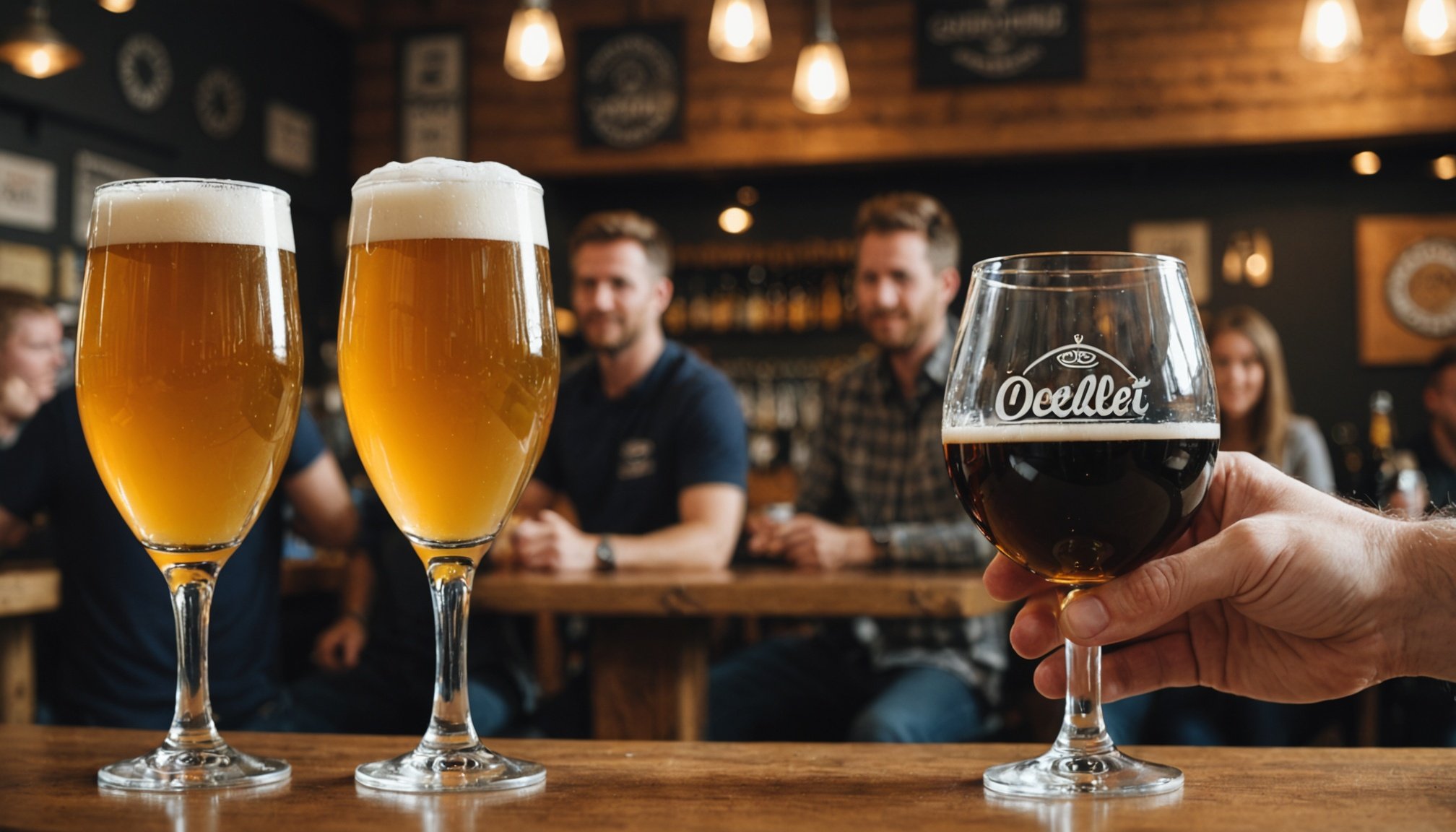Understanding the Importance of Customer Loyalty in Craft Beer
In the fiercely competitive UK craft beer market, building strong craft beer loyalty is crucial for sustaining long-term business success. The sheer variety available means customers have endless options, so establishing enduring relationships is vital. Customer retention goes beyond offering a unique product; it’s about creating a connection that keeps people coming back to your brand, amid a sea of craft beer choices.
Email marketing significance cannot be overstated in this context. It acts as a direct line of communication with your consumers, enabling you to share updates, promotions, and stories that resonate with their interests. A well-executed email strategy fosters engagement and reinforces loyalty by keeping your brand top-of-mind. Personalised emails can make customers feel valued and understood, further enhancing their commitment.
Also to discover : Unlock your creativity with our marketing video maker
To effectively leverage email marketing, consider segmenting your audience based on preferences or purchase history. This enables you to tailor messages that appeal specifically to different customer groups, making them more relevant and impactful. Ultimately, integrating these approaches into your marketing strategy can boost customer loyalty, giving you an edge in the bustling craft beer arena.
Effective Email Marketing Techniques for Craft Beer Brands
Crafting a compelling email newsletter starts with understanding your audience. Email marketing strategies that resonate involve creating content that aligns with the interests and values of your subscribers. For an effective campaign, focus on strong visuals and engaging storytelling to highlight your craft beer’s unique qualities.
Also to read : Harnessing TikTok: Innovative Tactics for UK Fitness Experts to Elevate Workouts and Attract Clients
Timing is crucial. Optimal email campaign engagement is often achieved by paying close attention to when your audience is most likely to read their emails. Common best practices suggest sending newsletters mid-week during the late mornings. However, always analyze your audience’s specific habits.
The frequency of emails should strike a balance—not too frequent to become a nuisance, but regular enough to keep your brand at the forefront of the customer’s mind. Personalisation extends beyond just using the recipient’s name; it includes tailored product recommendations based on previous purchases or viewing history.
Utilising automation can significantly enhance customer interactions. Automated emails ensure timely responses to customer actions, such as abandoned cart reminders. Setting up a series of guided emails based on the customer journey allows more relevant storytelling and upselling opportunities naturally.
When implemented thoughtfully, these craft beer email tactics can foster deeper engagement and strengthen brand loyalty.
Audience Segmentation for Better Email Targeting
In the bustling world of craft beer, effective audience segmentation can transform how brands connect with their clients, leading to personalized marketing that resonates deeply. Understanding customer demographics is key to crafting emails that truly speak to each segment of your audience.
Types of Audience Segmentation
Audience segmentation can take several forms, including geographic, demographic, psychographic, and behavioural categories. Geographic segmentation involves dividing your audience based on their location. Demographic segmentation focuses on age, gender, income, and education level. Psychographic segmentation considers lifestyle, values, and personality traits. Behavioural segmentation is based on purchase history and interaction with the brand.
Tools for Segmenting Your Audience
Various tools, such as CRM (Customer Relationship Management) software and analytics platforms, are equipped to gather and analyse data for segmentation. These tools enable marketers to create profiles reflecting diverse customer needs, facilitating more personalized marketing efforts.
Benefits of Segmentation in Email Campaigns
Implementing segmentation strategies in email campaigns can dramatically enhance customer engagement. By targeting specific segments with tailored content, brands can create more impactful connections, improve response rates, and achieve greater customer retention. Real-life examples from successful craft beer brands demonstrate how segmentation can foster deeper loyalty and increase sales by delivering messages that align closely with individual preferences.
Personalization Strategies to Enhance Engagement
Email personalization is an essential tactic for increasing engagement, offering a more profound customer experience. This approach customizes content to reflect individual preferences and actions, boosting feelings of value and understanding among subscribers. Techniques such as using customer names, crafting messages based on previous interactions, and highlighting local events can elevate the engagement level significantly.
Targeted messaging ensures that emails resonate with the recipient’s interests. For instance, recommending limited-edition craft beers based on past purchases can enhance relevance. Such recommendations not only make customers feel appreciated but also promote additional sales and deepen loyalty.
Case studies from the craft beer industry illustrate successful personalization tactics. Personalized birthday offers, exclusive event invitations, and early access to new product launches showcase the power of tailored communication, leading to higher conversion rates and brand affinity.
To implement effective personalization, use data analytics to gather insights into customer behavior and preferences. Integrating CRM systems with email platforms allows for seamless data utilization, ensuring that every interaction becomes an opportunity for a personalized experience. Ultimately, these strategies foster a loyal customer base and expand engagement.
Creating Engaging Email Content Ideas for Craft Breweries
In the vibrant world of craft beer, generating engaging content is vital to capture and retain customer interest. One approach is to innovate by sharing behind-the-scenes glimpses of the brewing process, which piques curiosity and strengthens the connection between brand and consumer. Seasonal promotions and recipes that incorporate your craft beers can also add value to your communication.
Effective craft beer storytelling is essential for crafting appealing narratives. Share the unique stories behind your beers, the origin of ingredients, or even anecdotes from your brewing team. This storytelling not only informs but also inspires loyalty by fostering an emotional bond with your subscribers.
Email design should be responsive and visually appealing, ensuring an optimal view across all devices, particularly mobile ones. Clear, eye-catching visuals paired with concise text make the message more effective.
Incorporate storytelling elements consistently to reinforce brand identity and maintain engagement. Elements like a narrative arc or thematic sequence can elevate emails from mere promotions to engaging newsletters, fostering deeper customer connections.
In summary, crafting inventive, visually appealing, and narrative-rich emails helps maintain a significant presence in the minds of craft beer enthusiasts, effectively bolstering customer loyalty.
Metrics for Measuring Email Marketing Success
Evaluating the success of your email marketing campaigns hinges on understanding key performance metrics. These insights allow you to fine-tune strategies and maximise impact.
Key Performance Indicators (KPIs) for Email Marketing
To gauge campaign success, focus on metrics such as open rates, click-through rates, conversion rates, and unsubscribe rates. Each KPI provides specific insights: while open rates reveal how engaging your subject lines are, click-through rates indicate the effectiveness of your call-to-action.
Tools for Measuring Email Campaign Success
Utilise tools like Google Analytics and Mailchimp to track these metrics efficiently. These platforms offer detailed analytics that help understand user engagement and pinpoint areas for improvement.
Analyzing Data to Improve Future Campaigns
Once you’ve collected data, conduct A/B testing to refine your email strategies. Experiment with different email components, like subject lines, send times, or imagery, to identify what resonates best. Additionally, feedback loops—where customer responses shape your approach—can drive continuous improvements.
By diligently tracking and analysing these metrics, you empower your brand to optimise its email marketing efforts, ultimately fostering stronger connections and building enhanced customer loyalty.
Successful Case Studies of UK Craft Beer Brands
Delving into the successful campaigns of UK craft beer brands offers invaluable insights into effective craft beer best practices. These brands have demonstrated remarkable acumen by leveraging email marketing to foster stronger consumer relationships and boost customer loyalty.
Many craft breweries have employed unique strategies that resonate emotionally with their audience. For instance, some have created campaigns that highlight their eco-friendly brewing processes, effectively engaging customers who value sustainability. This approach not only draws attention to their environmental efforts but also builds an emotional connection with those who prioritise green practices.
Another notable example involves brands that have tailored email content to align with local events or seasons. By delivering newsletters featuring exclusive limited-edition releases synced with regional festivals, these brands have heightened consumer anticipation and engagement.
The lessons from these successful campaigns emphasize the importance of authenticity and relevance. Effective email marketing in the craft beer industry is not just about showcasing products but about telling a brand story that resonates and retains customer interest. By adopting these practices, other craft breweries can enhance their email marketing efforts and build lasting consumer loyalty.
Practical Steps and Tools for Implementing Strategies
In the sphere of email marketing tools and implementation strategies for craft breweries, understanding the right tools and steps is crucial for campaign success. Efficient management starts with selecting a robust platform like Mailchimp or Constant Contact, designed to streamline the entire email marketing process.
Recommended Tools for Email Marketing Management
- Mailchimp: Offers comprehensive analytics and automation features ideal for segmenting audiences and personalising messages.
- Constant Contact: Known for its user-friendly interface and advanced email tracking capabilities.
- HubSpot: Combines CRM tools with marketing features for cohesive customer communications.
Step-by-Step Guide to Setting Up an Email Campaign
- Define Your Audience: Begin with thorough audience segmentation based on demographics and behaviours.
- Craft Engaging Content: Develop creative and engaging content, focusing on visuals and storytelling.
- Schedule Smartly: Use analytics to determine optimal timing and frequency for send-outs.
Tips for Testing and Iterating on Your Email Marketing Approach
- A/B Testing: Regularly test different subject lines, visuals, and calls to action to understand what resonates best.
- Feedback Loops: Implement systems for evaluating responses and adapting strategies for ongoing improvements.
These actionable steps and tools provide a foundation for implementing effective marketing strategies, crucial for attaining loyalty in the competitive craft beer industry.











